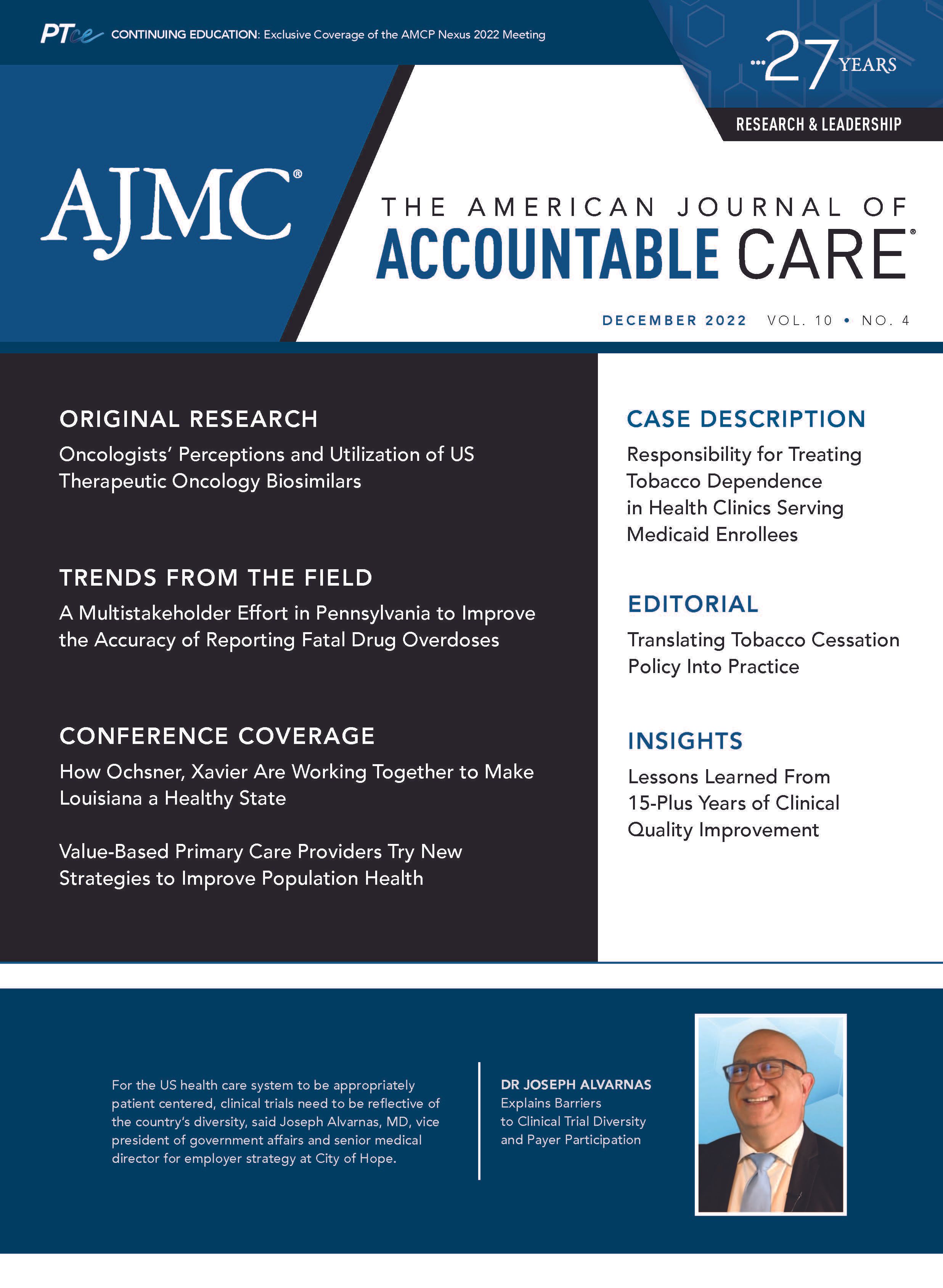Publication
Article
Population Health, Equity & Outcomes
Translating Tobacco Cessation Policy Into Practice
Author(s):
Further understanding of effective incentives and disincentives is needed to ensure that evidence-based policy and guidelines regarding tobacco cessation are effectively translated into practice at the patient level.
Am J Accountable Care. 2022;10(4):36-37. https://doi.org/10.37765/ajac.2022.89286
Tobacco has been identified as the leading actual cause of death in the United States.1 Although there has been considerable progress in reducing the overall rate of tobacco use in the nation through public health initiatives, individuals from communities with low income have higher rates of tobacco use than the general population.2 Because most tobacco users see a primary care clinician each year,3 community clinics, as part of the health care safety net, represent an important channel to increase cessation and lower the prevalence of tobacco use in populations with high rates.
In this issue of The American Journal of Accountable Care®, the case study titled “Responsibility for Treating Tobacco Dependence in Health Clinics Serving Medicaid Enrollees” addresses an important issue—namely, how medical policy is translated into practice in the context of a large Medicaid managed care system.4 The case shows the complexity of such a system, elements of which include CMS determining federal Medicaid policy; California state government administering the Medi-Cal program, including contracting with multiple health plans; and health plans, in turn, contracting with a variety of provider organizations such as community clinics, independent practice associations, and medical groups.
The paper focuses on how elements of a state policy detailing Medi-Cal plan requirements for tobacco cessation, specified in an All Plan Letter (APL), were implemented at a single community clinic. The intent of the APL was to specify tobacco cessation best practices with the expectation of implementation that would benefit Medi-Cal members using tobacco. Of 13 APL requirements, 8 were completely followed by the clinic, 2 were partially followed, and 3 were not followed at all. The authors noted that previous research showed that only 1 of 25 Medi-Cal managed care plans (MCPs) adopted all APL requirements.5 In addition, the researchers found that the community clinic did not have requirements related to the APL in any of the 6 MCP contracts that were in place during the study period.
Perhaps the most important lesson from this case study is the ongoing need to evaluate health care quality in Medicaid, across the system, from CMS down to the level of care provided at the individual patient level. Such an examination can pinpoint problems in performance or translation that reduce the effectiveness of evidence-based policy and guidelines. A decade ago, Kizer and Kirsh described the “double-edged sword” of performance measurement. They noted that it takes thoughtful implementation design and careful evaluation to demonstrate that specific performance measurements are actually benefiting patients and not potentially causing harm.6
Left for future research is identification of the most effective strategies to ensure that tobacco cessation clinical policy, as well as other quality improvement targets, are effectively put into practice. The authors note the lack of contractual language at both the plan and clinic levels mandating compliance with the APL, yet the studied clinic was meeting the majority of the 13 APL requirements. In addition, contractual language alone cannot drive health care quality across quality metrics.
One approach that clinicians and policy makers have called for is a reduction in the administrative burden felt across the health care system. As cited in the case study, the California Department of Health Care Services, which administers the Medi-Cal program, moved in this direction by centralizing pharmacy benefits under the state, thus standardizing benefits and simplifying how medications reach patients. For example, requirements for prior authorization to prescribe varenicline and bupropion were removed under the new system.7
The COVID-19 pandemic has only heightened the need to improve the effectiveness of tobacco cessation services since a recent study documented a pandemic-related decrease in cessation counseling, along with decrements in the delivery of other clinical preventive services in community clinics.8 Fortunately, several recent papers have outlined current best clinical practices in tobacco cessation, including system-based guidance.9-11 In addition, the Tobacco Cessation Change Package, part of the Million Hearts program delivered by the CDC, provides detailed, practical recommendations on how to optimize cessation efforts in the primary care setting.12
An ongoing challenge in clinics, however, is how to effectively deliver all the currently recommended, evidence-based services, given the relentless time pressures that exist in the primary care setting.13 In addition to employing team-based care to optimize efficiency, this case study reminds us that policy makers must do their part to reduce administrative burdens. Further understanding of effective incentives and disincentives is needed to ensure that evidence-based policy and guidelines are effectively translated into practice at the patient level.
Author Affiliation: Prevention Policy & Practice Group, Center for Healthcare Policy and Research, University of California, Davis, Sacramento, CA.
Source of Funding: None.
Author Disclosures: The author reports no relationship or financial interest with any entity that would pose a conflict of interest with the subject matter of this article.
Authorship Information: Concept and design; analysis and interpretation of data; and drafting of the manuscript.
Send Correspondence to: Neal D. Kohatsu, MD, MPH, Prevention Policy & Practice Group, Center for Healthcare Policy and Research, University of California, Davis, 4900 Broadway, Ste 1621, Sacramento, CA 95820. Email: ndkohatsu@ucdavis.edu.
REFERENCES
1. Mokdad AH, Marks JS, Stroup DF, Gerberding JL. Actual causes of death in the United States, 2000. JAMA. 2004;291(10):1238-1245. doi:10.1001/jama.291.10.1238
2. Cornelius ME, Loretan CG, Wang TW, Jamal A, Homa DM. Tobacco product use among adults – United States, 2020. MMWR Morb Mortal Wkly Rep. 2022;71(11):397-405. doi:10.15585/mmwr.mm7111a1
3. CDC. Physician and other health-care professional counseling of smokers to quit – United States, 1991. MMWR Morb Mortal Wkly Rep. 1993;42(44):854-857.
4. Tam A, Brouwer KC, Liu J, et al. Responsibility for treating tobacco dependence in health clinics serving Medicaid enrollees. Am J Accountable Care. 2022;10(4):29-34. doi:10.37765/ajac.2022.89285
5. McMenamin SB, Yoeun SW, Wellman JP, Zhu SH. Implementation of a comprehensive tobacco-cessation policy in Medicaid managed care plans in California. Am J Prev Med. 2020;59(4):593-596. doi:10.1016/
j.amepre.2020.04.007
6. Kizer KW, Kirsh SR. The double edged sword of performance measurement. J Gen Intern Med. 2012;27(4):395-397. doi:10.1007/s11606-011-1981-5
7. Medi-Cal Rx: education & outreach. California Department of Health Care Services. Accessed October 18, 2022. https://medi-calrx.dhcs.ca.gov/home/education
8. Star J, Han X, Makaroff L, Minihan A, Jemal A, Bandi P. The first year of the COVID-19 pandemic: changes in preventive services in community health centers. Am J Prev Med. Published online October 20, 2022. doi:10.1016/j.amepre.2022.08.023
9. Rigotti NA, Kruse GR, Livingstone-Banks J, Hartmann-Boyce J. Treatment of tobacco smoking: a review. JAMA. 2022;327(6):566-577. doi:10.1001/jama.2022.0395
10. Pipe AL, Evans W, Papadakis S. Smoking cessation: health system challenges and opportunities. Tob Control. 2022;31(2):340-347. doi:10.1136/tobaccocontrol-2021-056575
11. Selby P, Zawertailo L. Tobacco addiction. N Engl J Med. 2022;387(4):345-354. doi:10.1056/NEJMcp2032393
12. Tobacco cessation change package. Million Hearts. Accessed October 12, 2022. https://millionhearts.hhs.gov/tools-protocols/action-guides/tobacco-change-package/index.html
13. Porter J, Boyd C, Skandari MR, Laiteerapong N. Revisiting the time needed to provide adult primary care. J Gen Intern Med. Published online July 1, 2022. doi:10.1007/s11606-022-07707-x







